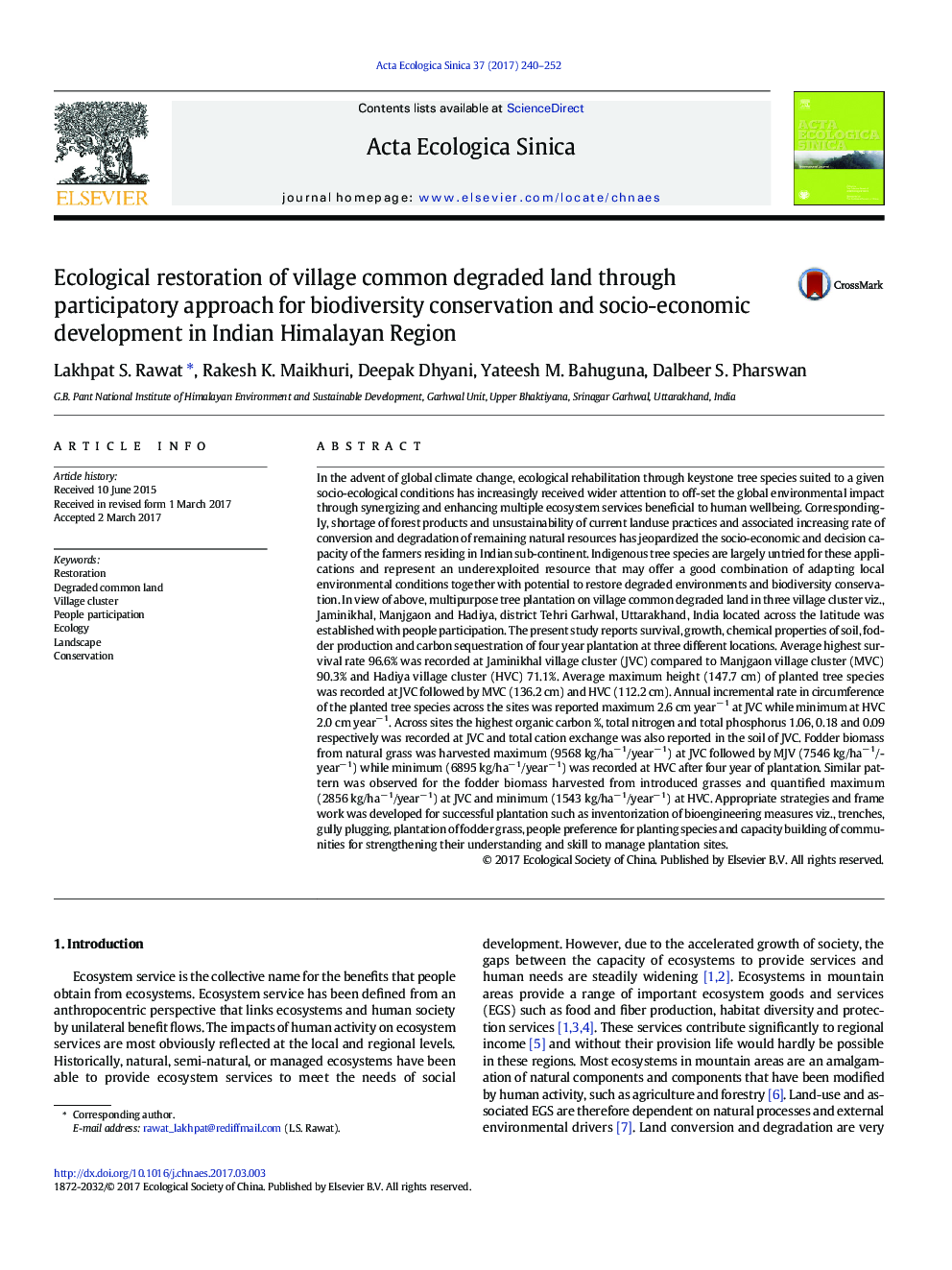| کد مقاله | کد نشریه | سال انتشار | مقاله انگلیسی | نسخه تمام متن |
|---|---|---|---|---|
| 8846362 | 1617673 | 2017 | 13 صفحه PDF | دانلود رایگان |
عنوان انگلیسی مقاله ISI
Ecological restoration of village common degraded land through participatory approach for biodiversity conservation and socio-economic development in Indian Himalayan Region
ترجمه فارسی عنوان
بازسازی زیست محیطی روستاها از طریق رویکرد مشارکتی برای حفاظت از تنوع زیستی و توسعه اجتماعی و اقتصادی در منطقه هیمالیا هند
دانلود مقاله + سفارش ترجمه
دانلود مقاله ISI انگلیسی
رایگان برای ایرانیان
کلمات کلیدی
ترمیم، زمین های متعارف تخریب شده، خوشه روستا، مشارکت مردم، محیط زیست، چشم انداز، حفاظت،
موضوعات مرتبط
علوم زیستی و بیوفناوری
علوم کشاورزی و بیولوژیک
بوم شناسی، تکامل، رفتار و سامانه شناسی
چکیده انگلیسی
In the advent of global climate change, ecological rehabilitation through keystone tree species suited to a given socio-ecological conditions has increasingly received wider attention to off-set the global environmental impact through synergizing and enhancing multiple ecosystem services beneficial to human wellbeing. Correspondingly, shortage of forest products and unsustainability of current landuse practices and associated increasing rate of conversion and degradation of remaining natural resources has jeopardized the socio-economic and decision capacity of the farmers residing in Indian sub-continent. Indigenous tree species are largely untried for these applications and represent an underexploited resource that may offer a good combination of adapting local environmental conditions together with potential to restore degraded environments and biodiversity conservation. In view of above, multipurpose tree plantation on village common degraded land in three village cluster viz., Jaminikhal, Manjgaon and Hadiya, district Tehri Garhwal, Uttarakhand, India located across the latitude was established with people participation. The present study reports survival, growth, chemical properties of soil, fodder production and carbon sequestration of four year plantation at three different locations. Average highest survival rate 96.6% was recorded at Jaminikhal village cluster (JVC) compared to Manjgaon village cluster (MVC) 90.3% and Hadiya village cluster (HVC) 71.1%. Average maximum height (147.7 cm) of planted tree species was recorded at JVC followed by MVC (136.2 cm) and HVC (112.2 cm). Annual incremental rate in circumference of the planted tree species across the sites was reported maximum 2.6 cm yearâ 1 at JVC while minimum at HVC 2.0 cm yearâ 1. Across sites the highest organic carbon %, total nitrogen and total phosphorus 1.06, 0.18 and 0.09 respectively was recorded at JVC and total cation exchange was also reported in the soil of JVC. Fodder biomass from natural grass was harvested maximum (9568 kg/haâ 1/yearâ 1) at JVC followed by MJV (7546 kg/haâ 1/yearâ 1) while minimum (6895 kg/haâ 1/yearâ 1) was recorded at HVC after four year of plantation. Similar pattern was observed for the fodder biomass harvested from introduced grasses and quantified maximum (2856 kg/haâ 1/yearâ 1) at JVC and minimum (1543 kg/haâ 1/yearâ 1) at HVC. Appropriate strategies and frame work was developed for successful plantation such as inventorization of bioengineering measures viz., trenches, gully plugging, plantation of fodder grass, people preference for planting species and capacity building of communities for strengthening their understanding and skill to manage plantation sites.
ناشر
Database: Elsevier - ScienceDirect (ساینس دایرکت)
Journal: Acta Ecologica Sinica - Volume 37, Issue 4, August 2017, Pages 240-252
Journal: Acta Ecologica Sinica - Volume 37, Issue 4, August 2017, Pages 240-252
نویسندگان
Lakhpat S. Rawat, Rakesh K. Maikhuri, Deepak Dhyani, Yateesh M. Bahuguna, Dalbeer S. Pharswan,
